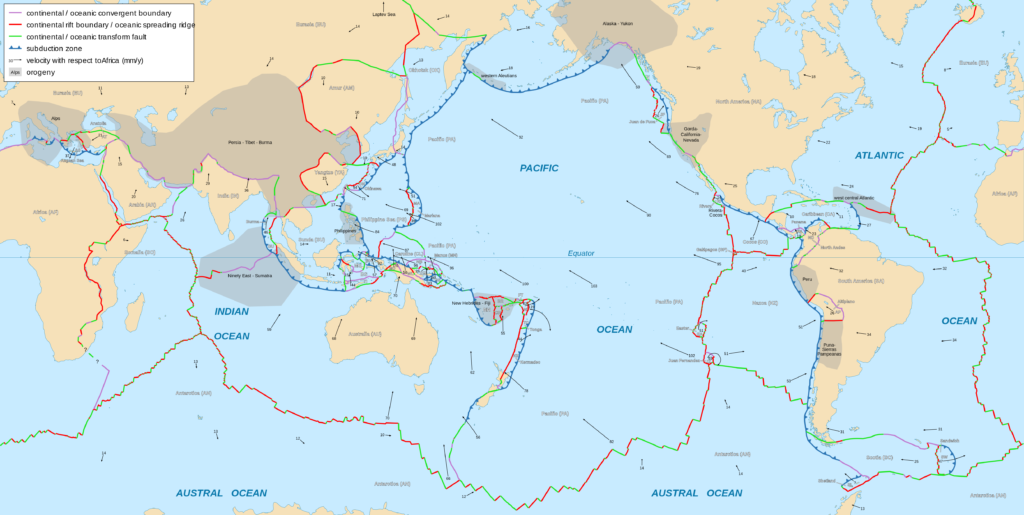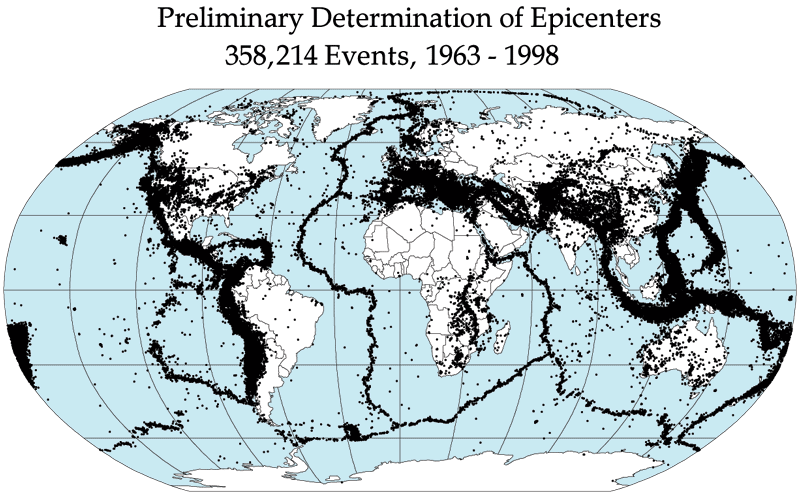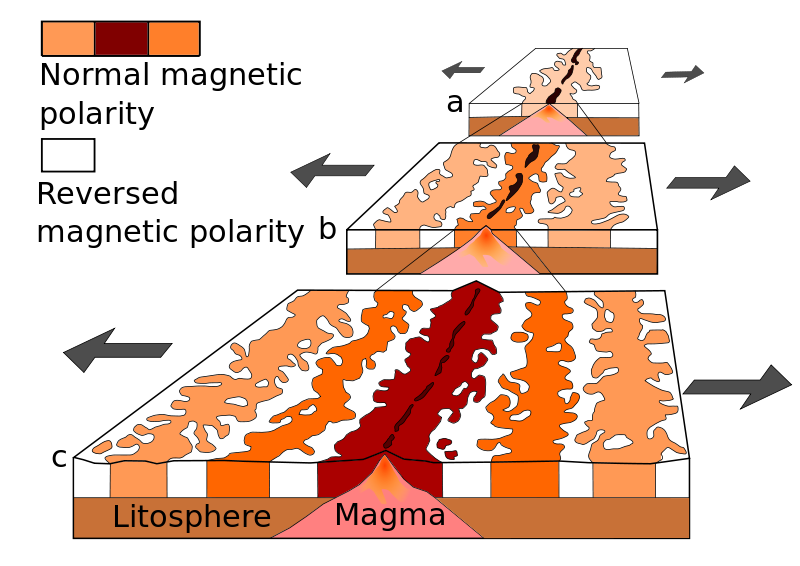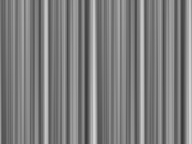In line with other previous and contemporaneous proposals, in 1912 the meteorologist Alfred Wegener amply described what he called continental drift, expanded in his 1915 book The Origin of Continents and Oceans[1], and the scientific debate started that would end up fifty years later in the theory of plate tectonics.[2] Starting from the idea (also expressed by his forerunners) that the present continents once formed a single land mass (which was called Pangea later on) that drifted apart, thus releasing the continents from the Earth’s mantle and likening them to “icebergs” of low density granite floating on a sea of denser basalt.[3]
Supporting evidence for the idea came from the dove-tailing outlines of South America’s east coast and Africa’s west coast, and from the matching of the rock formations along these edges. Confirmation of their previous contiguous nature also came from the fossil plants Glossopteris and Gangamopteris, and the therapsid or mammal-like reptile Lystrosaurus, all widely distributed over South America, Africa, Antarctica, India and Australia. The evidence for such an erstwhile joining of these continents was patent to field geologists working in the southern hemisphere. The South African Alex du Toit put together a mass of such information in his 1937 publication Our Wandering Continents, and went further than Wegener in recognising the strong links between the Gondwana fragments.

Figure 1. Detailed map showing the tectonic plates with their movement vectors. (Click on the image to open a larger version of the map.)
But without detailed evidence and a force sufficient to drive the movement, the theory was not generally accepted: the Earth might have a solid crust and mantle and a liquid core, but there seemed to be no way that portions of the crust could move around. Distinguished scientists, such as Harold Jeffreys and Charles Schuchert, were outspoken critics of continental drift.
Despite much opposition, the view of continental drift gained support and a lively debate started between “drifters” or “mobilists” (proponents of the theory) and “fixists” (opponents). During the 1920s, 1930s and 1940s, the former reached important milestones proposing that convection currents might have driven the plate movements, and that spreading may have occurred below the sea within the oceanic crust. Concepts close to the elements now incorporated in plate tectonics were proposed by geophysicists and geologists (both fixists and mobilists) like Vening-Meinesz, Holmes, and Umbgrove.
One of the first pieces of geophysical evidence that was used to support the movement of lithospheric plates came from paleomagnetism. This is based on the fact that rocks of different ages show a variable magnetic field direction, evidenced by studies since the mid–nineteenth century. The magnetic north and south poles reverse through time, and, especially important in paleotectonic studies, the relative position of the magnetic north pole varies through time. Initially, during the first half of the twentieth century, the latter phenomenon was explained by introducing what was called “polar wander” (see apparent polar wander), i.e., it was assumed that the north pole location had been shifting through time. An alternative explanation, though, was that the continents had moved (shifted and rotated) relative to the north pole, and each continent, in fact, shows its own “polar wander path”. During the late 1950s it was successfully shown on two occasions that these data could show the validity of continental drift: by Keith Runcorn in a paper in 1956,[4] and by Warren Carey in a symposium held in March 1956.[5]
The second piece of evidence in support of continental drift came during the late 1950s and early 60s from data on the bathymetry of the deep ocean floors and the nature of the oceanic crust such as magnetic properties and, more generally, with the development of marine geology which gave evidence for the association of seafloor spreading along the mid-oceanic ridges and magnetic field reversals, published between 1959 and 1963 by Heezen, Dietz, Hess, Mason, Vine & Matthews, and Morley.[6]
Simultaneous advances in early seismic imaging techniques in and around Wadati-Benioff zones along the trenches bounding many continental margins, together with many other geophysical (e.g. gravimetric) and geological observations, showed how the oceanic crust could disappear into the mantle, providing the mechanism to balance the extension of the ocean basins with shortening along its margins.
All this evidence, both from the ocean floor and from the continental margins, made it clear around 1965 that continental drift was feasible and the theory of plate tectonics, which was defined in a series of papers between 1965 and 1967, was born, with all its extraordinary explanatory and predictive power. The theory revolutionized the Earth sciences, explaining a diverse range of geological phenomena and their implications in other studies such as paleogeography and paleobiology.
Continental Drift

Figure 2. Alfred Wegener in Greenland in the winter of 1912-13.
In the late nineteenth and early twentieth centuries, geologists assumed that the Earth’s major features were fixed, and that most geologic features such as basin development and mountain ranges could be explained by vertical crustal movement, described in what is called the geosynclinal theory. Generally, this was placed in the context of a contracting planet Earth due to heat loss in the course of a relatively short geological time.
It was observed as early as 1596 that the opposite coasts of the Atlantic Ocean—or, more precisely, the edges of the continental shelves—have similar shapes and seem to have once fitted together.[7]
Since that time many theories were proposed to explain this apparent complementarity, but the assumption of a solid Earth made these various proposals difficult to accept.[8]
The discovery of radioactivity and its associated heating properties in 1895 prompted a re-examination of the apparent age of the Earth.[9] This had previously been estimated by its cooling rate and assumption the Earth’s surface radiated like a black body.[10] Those calculations had implied that, even if it started at red heat, the Earth would have dropped to its present temperature in a few tens of millions of years. Armed with the knowledge of a new heat source, scientists realized that the Earth would be much older, and that its core was still sufficiently hot to be liquid.
By 1915, after having published a first article in 1912,[11] Alfred Wegener was making serious arguments for the idea of continental drift in the first edition of The Origin of Continents and Oceans.[12] In that book (re-issued in four successive editions up to the final one in 1936), he noted how the east coast of South America and the west coast of Africa looked as if they were once attached. Wegener was not the first to note this (Abraham Ortelius, Antonio Snider-Pellegrini, Eduard Suess, Roberto Mantovani and Frank Bursley Taylor preceded him just to mention a few), but he was the first to marshal significant fossil and paleo-topographical and climatological evidence to support this simple observation (and was supported in this by researchers such as Alex du Toit). Furthermore, when the rock strata of the margins of separate continents are very similar it suggests that these rocks were formed in the same way, implying that they were joined initially. For instance, parts of Scotland and Ireland contain rocks very similar to those found in Newfoundland and New Brunswick. Furthermore, the Caledonian Mountains of Europe and parts of the Appalachian Mountainsof North America are very similar in structure and lithology.
However, his ideas were not taken seriously by many geologists, who pointed out that there was no apparent mechanism for continental drift. Specifically, they did not see how continental rock could plow through the much denser rock that makes up oceanic crust. Wegener could not explain the force that drove continental drift, and his vindication did not come until after his death in 1930.
Floating Continents, Paleomagnetism, and Seismicity Zones
As it was observed early that although granite existed on continents, seafloor seemed to be composed of denser basalt, the prevailing concept during the first half of the twentieth century was that there were two types of crust, named “sial” (continental type crust) and “sima” (oceanic type crust). Furthermore, it was supposed that a static shell of strata was present under the continents. It therefore looked apparent that a layer of basalt (sial) underlies the continental rocks.

Figure 3. Global earthquake epicenters, 1963–1998
However, based on abnormalities in plumb line deflection by the Andes in Peru, Pierre Bouguer had deduced that less-dense mountains must have a downward projection into the denser layer underneath. The concept that mountains had “roots” was confirmed by George B. Airy a hundred years later, during study of Himalayan gravitation, and seismic studies detected corresponding density variations. Therefore, by the mid-1950s, the question remained unresolved as to whether mountain roots were clenched in surrounding basalt or were floating on it like an iceberg.
During the 20th century, improvements in and greater use of seismic instruments such as seismographs enabled scientists to learn that earthquakes tend to be concentrated in specific areas, most notably along the oceanic trenches and spreading ridges. By the late 1920s, seismologists were beginning to identify several prominent earthquake zones parallel to the trenches that typically were inclined 40–60° from the horizontal and extended several hundred kilometers into the Earth. These zones later became known as Wadati-Benioff zones, or simply Benioff zones, in honor of the seismologists who first recognized them, Kiyoo Wadati of Japan and Hugo Benioff of the United States. The study of global seismicity greatly advanced in the 1960s with the establishment of the Worldwide Standardized Seismograph Network (WWSSN)[13] to monitor the compliance of the 1963 treaty banning above-ground testing of nuclear weapons. The much improved data from the WWSSN instruments allowed seismologists to map precisely the zones of earthquake concentration worldwide.
Meanwhile, debates developed around the phenomena of polar wander. Since the early debates of continental drift, scientists had discussed and used evidence that polar drift had occurred because continents seemed to have moved through different climatic zones during the past. Furthermore, paleomagnetic data had shown that the magnetic pole had also shifted during time. Reasoning in an opposite way, the continents might have shifted and rotated, while the pole remained relatively fixed. The first time the evidence of magnetic polar wander was used to support the movements of continents was in a paper by Keith Runcorn in 1956,[14] and successive papers by him and his students Ted Irving (who was actually the first to be convinced of the fact that paleomagnetism supported continental drift) and Ken Creer.
This was immediately followed by a symposium in Tasmania in March 1956.[15] In this symposium, the evidence was used in the theory of an expansion of the global crust. In this hypothesis the shifting of the continents can be simply explained by a large increase in size of the Earth since its formation. However, this was unsatisfactory because its supporters could offer no convincing mechanism to produce a significant expansion of the Earth. Certainly there is no evidence that the moon has expanded in the past 3 billion years; other work would soon show that the evidence was equally in support of continental drift on a globe with a stable radius.
During the thirties up to the late fifties, works by Vening-Meinesz, Holmes, Umbgrove, and numerous others outlined concepts that were close or nearly identical to modern plate tectonics theory. In particular, the English geologist Arthur Holmes proposed in 1920 that plate junctions might lie beneath the sea, and in 1928 that convection currents within the mantle might be the driving force.[16] Often, these contributions are forgotten because:
- At the time, continental drift was not accepted.
- Some of these ideas were discussed in the context of abandoned fixistic ideas of a deforming globe without continental drift or an expanding Earth.
- They were published during an episode of extreme political and economic instability that hampered scientific communication.
- Many were published by European scientists and at first not mentioned or given little credit in the papers on sea floor spreading published by the American researchers in the 1960s.
Mid-Oceanic Ridge Spreading and Convection
In 1947, a team of scientists led by Maurice Ewing utilizing the Woods Hole Oceanographic Institution’s research vessel Atlantis and an array of instruments, confirmed the existence of a rise in the central Atlantic Ocean, and found that the floor of the seabed beneath the layer of sediments consisted of basalt, not the granite which is the main constituent of continents. They also found that the oceanic crust was much thinner than continental crust. All these new findings raised important and intriguing questions.[17]
The new data that had been collected on the ocean basins also showed particular characteristics regarding the bathymetry. One of the major outcomes of these datasets was that all along the globe, a system of mid-oceanic ridges was detected. An important conclusion was that along this system, new ocean floor was being created, which led to the concept of the “Great Global Rift.” This was described in the crucial paper of Bruce Heezen (1960),[18] which would trigger a real revolution in thinking. A profound consequence of seafloor spreading is that new crust was, and still is, being continually created along the oceanic ridges. Therefore, Heezen advocated the so-called “expanding Earth” hypothesis of S. Warren Carey (see above). So, still the question remained: how can new crust be continuously added along the oceanic ridges without increasing the size of the Earth? In reality, this question had been solved already by numerous scientists during the forties and the fifties, like Arthur Holmes, Vening-Meinesz, Coates and many others: The crust in excess disappeared along what were called the oceanic trenches, where so-called “subduction” occurred. Therefore, when various scientists during the early sixties started to reason on the data at their disposal regarding the ocean floor, the pieces of the theory quickly fell into place.
The question particularly intrigued Harry Hammond Hess, a Princeton University geologist and a Naval Reserve Rear Admiral, and Robert S. Dietz, a scientist with the U.S. Coast and Geodetic Survey who first coined the term seafloor spreading. Dietz and Hess (the former published the same idea one year earlier in Nature,[19] but priority belongs to Hess who had already distributed an unpublished manuscript of his 1962 article by 1960)[20] were among the small handful who really understood the broad implications of sea floor spreading and how it would eventually agree with the, at that time, unconventional and unaccepted ideas of continental drift and the elegant and mobilistic models proposed by previous workers like Holmes.
In the same year, Robert R. Coats of the U.S. Geological Survey described the main features of island arc subduction in the Aleutian Islands. His paper, though little noted (and even ridiculed) at the time, has since been called “seminal” and “prescient.” In reality, it actually shows that the work by the European scientists on island arcs and mountain belts performed and published during the 1930s up until the 1950s was applied and appreciated also in the United States.
If the Earth’s crust was expanding along the oceanic ridges, Hess and Dietz reasoned like Holmes and others before them, it must be shrinking elsewhere. Hess followed Heezen, suggesting that new oceanic crust continuously spreads away from the ridges in a conveyor belt–like motion. And, using the mobilistic concepts developed before, he correctly concluded that many millions of years later, the oceanic crust eventually descends along the continental margins where oceanic trenches—very deep, narrow canyons—are formed, e.g. along the rim of the Pacific Ocean basin. The important step Hess made was that convection currents would be the driving force in this process, arriving at the same conclusions as Holmes had decades before with the only difference that the thinning of the ocean crust was performed using Heezen’s mechanism of spreading along the ridges. Hess therefore concluded that the Atlantic Ocean was expanding while the Pacific Ocean was shrinking. As old oceanic crust is “consumed” in the trenches (like Holmes and others, he thought this was done by thickening of the continental lithosphere, not, as now understood, by underthrusting at a larger scale of the oceanic crust itself into the mantle), new magma rises and erupts along the spreading ridges to form new crust. In effect, the ocean basins are perpetually being “recycled,” with the creation of new crust and the destruction of old oceanic lithosphere occurring simultaneously. Thus, the new mobilistic concepts neatly explained why the Earth does not get bigger with sea floor spreading, why there is so little sediment accumulation on the ocean floor, and why oceanic rocks are much younger than continental rocks.
Magnetic Striping

Figure 4. Seafloor magnetic striping.
Beginning in the 1950s, scientists like Victor Vacquier, using magnetic instruments (magnetometers) adapted from airborne devices developed during World War II to detect submarines, began recognizing odd magnetic variations across the ocean floor. This finding, though unexpected, was not entirely surprising because it was known that basalt—the iron-rich, volcanic rock making up the ocean floor—contains a strongly magnetic mineral (magnetite) and can locally distort compass readings. This distortion was recognized by Icelandic mariners as early as the late eighteenth century. More important, because the presence of magnetite gives the basalt measurable magnetic properties, these newly discovered magnetic variations provided another means to study the deep ocean floor. When newly formed rock cools, such magnetic materials recorded the Earth’s magnetic field at the time.

Figure 5. A demonstration of magnetic striping. (The darker the color is, the closer it is to normal polarity)
As more and more of the seafloor was mapped during the 1950s, the magnetic variations turned out not to be random or isolated occurrences, but instead revealed recognizable patterns. When these magnetic patterns were mapped over a wide region, the ocean floor showed a zebra-like pattern: one stripe with normal polarity and the adjoining stripe with reversed polarity. The overall pattern, defined by these alternating bands of normally and reversely polarized rock, became known as magnetic striping, and was published by Ron G. Mason and co-workers in 1961, who did not find, though, an explanation for these data in terms of sea floor spreading, like Vine, Matthews and Morley a few years later.[21]
The discovery of magnetic striping called for an explanation. In the early 1960s scientists such as Heezen, Hess and Dietz had begun to theorise that mid-ocean ridges mark structurally weak zones where the ocean floor was being ripped in two lengthwise along the ridge crest (see the previous paragraph). New magma from deep within the Earth rises easily through these weak zones and eventually erupts along the crest of the ridges to create new oceanic crust. This process, at first denominated the “conveyer belt hypothesis” and later called seafloor spreading, operating over many millions of years continues to form new ocean floor all across the 50,000 km-long system of mid-ocean ridges.
Only four years after the maps with the “zebra pattern” of magnetic stripes were published, the link between sea floor spreading and these patterns was correctly placed, independently byLawrence Morley, and by Fred Vine and Drummond Matthews, in 1963,[22] now called the Vine-Matthews-Morley hypothesis. This hypothesis linked these patterns to geomagnetic reversals and was supported by several lines of evidence:[23]
- the stripes are symmetrical around the crests of the mid-ocean ridges; at or near the crest of the ridge, the rocks are very young, and they become progressively older away from the ridge crest;
- the youngest rocks at the ridge crest always have present-day (normal) polarity;
- stripes of rock parallel to the ridge crest alternate in magnetic polarity (normal-reversed-normal, etc.), suggesting that they were formed during different epochs documenting the (already known from independent studies) normal and reversal episodes of the Earth’s magnetic field.
By explaining both the zebra-like magnetic striping and the construction of the mid-ocean ridge system, the seafloor spreading hypothesis (SFS) quickly gained converts and represented another major advance in the development of the plate-tectonics theory. Furthermore, the oceanic crust now came to be appreciated as a natural “tape recording” of the history of the geomagnetic field reversals (GMFR) of the Earth’s magnetic field. Today, extensive studies are dedicated to the calibration of the normal-reversal patterns in the oceanic crust on one hand and known timescales derived from the dating of basalt layers in sedimentary sequences (magnetostratigraphy) on the other, to arrive at estimates of past spreading rates and plate reconstructions.
Definition and Refining of the Theory
After all these considerations, Plate Tectonics (or, as it was initially called “New Global Tectonics”) became quickly accepted in the scientific world, and numerous papers followed that defined the concepts:
- In 1965, Tuzo Wilson who had been a promotor of the sea floor spreading hypothesis and continental drift from the very beginning[24] added the concept of transform faults to the model, completing the classes of fault types necessary to make the mobility of the plates on the globe work out.[25]
- A symposium on continental drift was held at the Royal Society of London in 1965 which must be regarded as the official start of the acceptance of plate tectonics by the scientific community, and which abstracts are issued as Blacket, Bullard & Runcorn (1965). In this symposium, Edward Bullard and co-workers showed with a computer calculation how the continents along both sides of the Atlantic would best fit to close the ocean, which became known as the famous “Bullard’s Fit”.
- In 1966 Wilson published the paper that referred to previous plate tectonic reconstructions, introducing the concept of what is now known as the “Wilson Cycle.”[26]
- In 1967, at the American Geophysical Union’s meeting, W. Jason Morgan proposed that the Earth’s surface consists of 12 rigid plates that move relative to each other.[27]
- Two months later, Xavier Le Pichon published a complete model based on 6 major plates with their relative motions, which marked the final acceptance by the scientific community of plate tectonics.[28]
- In the same year, McKenzie and Parker independently presented a model similar to Morgan’s using translations and rotations on a sphere to define the plate motions.[29]
Contribute!
Candela Citations
- Plate tectonics. Provided by: Wikipedia. Located at: https://en.wikipedia.org/wiki/Plate_tectonics#Development_of_the_theory. License: CC BY-SA: Attribution-ShareAlike
- Wegener, Alfred (1929). Die Entstehung der Kontinente und Ozeane (4 ed.). Braunschweig: Friedrich Vieweg & Sohn Akt. Ges. ↵
- Hughes, Patrick (8 February 2001). "Alfred Wegener (1880–1930): A Geographic Jigsaw Puzzle." On the shoulders of giants. Earth Observatory, NASA. Retrieved 2007-12-26. ... on January 6, 1912, Wegener... proposed instead a grand vision of drifting continents and widening seas to explain the evolution of Earth's geography. ↵
- Wegener, Alfred (1966). The origin of continents and oceans. Biram John (translator). Courier Dover. p. 246; Hughes, Patrick (8 February 2001). "Alfred Wegener (1880-1930): The origin of continents and oceans." On the Shoulders of Giants. Earth Observatory, NASA. Retrieved 2007-12-26. "By his third edition (1922), Wegener was citing geological evidence that some 300 million years ago all the continents had been joined in a supercontinent stretching from pole to pole. He called it Pangaea (all lands),..." ↵
- Runcorn, S.K. (1956). "Paleomagnetic comparisons between Europe and North America". Proceedings, Geological Association of Canada 8 (1088): 7785. ↵
- Carey, S. W. (1958). "The tectonic approach to continental drift." In Carey, S.W. Continental Drift—A symposium, held in March 1956. Hobart: Univ. of Tasmania. pp. 177–363. Expanding Earth from p. 311 to p. 349. ↵
- Korgen, Ben J. (1995). "A voice from the past: John Lyman and the plate tectonics story" (PDF). Oceanography (The Oceanography Society) 8 (1): 19–20; Spiess, Fred; Kuperman, William (2003). "The Marine Physical Laboratory at Scripps" (PDF). Oceanography (The Oceanography Society) 16 (3): 45–54. ↵
- Kious, W. Jacquelyne; Tilling, Robert I. (February 2001) [1996]. "Historical perspective." This Dynamic Earth: the Story of Plate Tectonics (Online ed.). U.S. Geological Survey. Retrieved 2008-01-29. "Abraham Ortelius in his work Thesaurus Geographicus... suggested that the Americas were 'torn away from Europe and Africa . . . by earthquakes and floods. . . . The vestiges of the rupture reveal themselves, if someone brings forward a map of the world and considers carefully the coasts of the three [continents].'" ↵
- Frankel, H. (1987). "The Continental Drift Debate." In H.T. Engelhardt Jr and A.L. Caplan. Scientific Controversies: Case Solutions in the resolution and closure of disputes in science and technology. Cambridge University Press. ↵
- Joly, John (1909). Radioactivity and Geology: An Account of the Influence of Radioactive Energy on Terrestrial History. London: Archibald Constable. p. 36. ↵
- Thomson, W (1863). "On the secular cooling of the earth." Philosophical Magazine 4 (25): 1–14 (inactive 2015-01-09). ↵
- Wegener, Alfred (6 January 1912). "Die Herausbildung der Grossformen der Erdrinde (Kontinente und Ozeane), auf geophysikalischer Grundlage" (PDF). Petermanns Geographische Mitteilungen 63: 185–195, 253–256, 305–309. ↵
- Wegener 1929. ↵
- Stein, Seth; Wysession, Michael (2009). An Introduction to Seismology, Earthquakes, and Earth Structure. Chichester: John Wiley & Sons. ↵
- Runcorn, 1956 ↵
- Carey, S. W. (1958). "The tectonic approach to continental drift". In Carey, S.W. Continental Drift—A symposium, held in March 1956. Hobart: Univ. of Tasmania. pp. 177–363. Expanding Earth from p. 311 to p. 349; see also Quilty, Patrick G.; Banks, Maxwell R. (2003). "Samuel Warren Carey, 1911–2002." Biographical memoirs. Australian Academy of Science. Retrieved 2010-06-19. This memoir was originally published in Historical Records of Australian Science (2003) 14 (3). ↵
- Holmes, Arthur (1928). "Radioactivity and Earth movements." Transactions of the Geological Society of Glasgow 18: 559–606; see also Holmes, Arthur (1978). Principles of Physical Geology (3 ed.). Wiley. pp. 640–641; Frankel, Henry (July 1978). "Arthur Holmes and continental drift." The British Journal for the History of Science 11 (2): 130–150. doi: 10.1017/S0007087400016551. ↵
- Lippsett, Laurence (2001). "Maurice Ewing and the Lamont-Doherty Earth Observatory." Living Legacies. Retrieved 2008-03-04; Lippsett, Laurence (2006). "Maurice Ewing and the Lamont-Doherty Earth Observatory". In William Theodore De Bary, Jerry Kisslinger and Tom Mathewson. Living Legacies at Columbia. Columbia University Press. pp. 277–297. ↵
- Heezen, B. (1960). "The rift in the ocean floor." Scientific American 203 (4): 98–110. doi: 10.1038/scientificamerican1060-98. ↵
- Dietz, Robert S. (June 1961). "Continent and Ocean Basin Evolution by Spreading of the Sea Floor". Nature 190 (4779): 854–857. ↵
- Hess, H. H. (November 1962). "History of Ocean Basins" (PDF). In A. E. J. Engel, Harold L. James, and B. F. Leonard. Petrologic studies: a volume to honor of A. F. Buddington. Boulder, CO: Geological Society of America. pp. 599–620. ↵
- Mason, Ronald G.; Raff, Arthur D. (1961). "Magnetic survey off the west coast of the United States between 32°N latitude and 42°N latitude." Bulletin of the Geological Society of America 72 (8): 1259–1266. ↵
- Vine, F.J.; Matthews, D.H. (1963). "Magnetic anomalies over oceanic ridges." Nature 199 (4897): 947–949. ↵
- See summary in Heirtzler, James R.; Le Pichon, Xavier; Baron, J. Gregory (1966). "Magnetic anomalies over the Reykjanes Ridge." Deep-Sea Research 13 (3): 427–432. ↵
- Wilson, J.T. (8 June 1963). "Hypothesis on the Earth's behaviour." Nature 198 (4884): 849–865. ↵
- Wilson, J. Tuzo (July 1965). "A new class of faults and their bearing on continental drift." Nature 207 (4995): 343–347. ↵
- Wilson, J. Tuzo (13 August 1966). "Did the Atlantic close and then re-open?" Nature 211 (5050): 676–681. ↵
- Morgan, W. Jason (1968). "Rises, Trenches, Great Faults, and Crustal Blocks." Journal of Geophysical Research 73 (6): 1959–1982. ↵
- Le Pichon, Xavier (15 June 1968). "Sea-floor spreading and continental drift." Journal of Geophysical Research 73 (12): 3661–3697. ↵
- Mc Kenzie, D.; Parker, R.L. (1967). "The North Pacific: an example of tectonics on a sphere." Nature 216 (5122): 1276–1280. ↵
